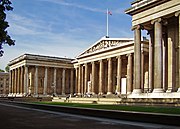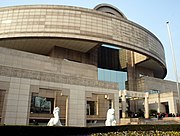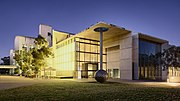Portal:Museums: Difference between revisions
Anomalocaris (talk | contribs) m properly close <div> |
|||
| (7 intermediate revisions by 5 users not shown) | |||
| Line 1: | Line 1: | ||
| ⚫ | |||
{{mfd|help=off}} |
|||
| ⚫ | |||
| ⚫ | |||
{{Portal description}} |
|||
| ⚫ | |||
{{Portals browsebar}} |
{{Portals browsebar}} |
||
__NOTOC__ __NOEDITSECTION__ |
|||
<div style="clear:both; width:100%"> |
<div style="clear:both; width:100%"> |
||
{{Box-header colour| |
{{Box-header colour|<big>The Museums Portal</big>| colour= | mode= }} <!-- |
||
{{Portal image banner|}}--> |
{{Portal image banner|}}--> |
||
{{Transclude lead excerpt|Museums| paragraphs=1-2 | files=1}} |
{{Transclude lead excerpt|Museums| paragraphs=1-2 | files=1}} |
||
| Line 79: | Line 76: | ||
}} |
}} |
||
{{Box-footer}} |
{{Box-footer}} |
||
{{Box-header colour|Selected interior|noedit=yes|}} |
{{Box-header colour|Selected interior image|noedit=yes|}} |
||
{{Random slideshow |
{{Random slideshow |
||
| File:20170420 Beinecke Rare Book Library Interior Yale University New Haven Connecticut.jpg | [[Beinecke Rare Book & Manuscript Library]], [[Yale]] |
| File:20170420 Beinecke Rare Book Library Interior Yale University New Haven Connecticut.jpg | [[Beinecke Rare Book & Manuscript Library]], [[Yale]] |
||
| Line 133: | Line 130: | ||
}} <!-- END OF ifexist --> |
}} <!-- END OF ifexist --> |
||
|2=<!-- SECOND COLUMN --> |
|2=<!-- SECOND COLUMN --> |
||
{{Box-header colour|Selected exterior|noedit=yes|}} |
{{Box-header colour|Selected exterior image|noedit=yes|}} |
||
{{Random slideshow |
{{Random slideshow |
||
| File:Louvre Museum Wikimedia Commons.jpg | The [[Louvre]], Paris, showing the glass-and-metal [[Louvre Pyramid|Pyramid]], designed by [[I. M. Pei]] to act as the museum's main entrance, and completed in 1989 |
| File:Louvre Museum Wikimedia Commons.jpg | The [[Louvre]], Paris, showing the glass-and-metal [[Louvre Pyramid|Pyramid]], designed by [[I. M. Pei]] to act as the museum's main entrance, and completed in 1989 |
||
| Line 153: | Line 150: | ||
| File:Courtyard of the museum, 2014-12-05.jpg | Small cloister of the charterhouse of [[Santa Maria degli Angeli e dei Martiri]], built on the site of the [[Baths of Diocletian]]; part of the [[National Roman Museum]] of Rome |
| File:Courtyard of the museum, 2014-12-05.jpg | Small cloister of the charterhouse of [[Santa Maria degli Angeli e dei Martiri]], built on the site of the [[Baths of Diocletian]]; part of the [[National Roman Museum]] of Rome |
||
| File:Brama Arbeit Macht frei.jpg | Entrance to [[Auschwitz|Auschwitz I]], part of the [[Auschwitz-Birkenau Memorial and Museum]], a [[Holocaust]] museum on the site of the former [[Nazi concentration camps]] |
| File:Brama Arbeit Macht frei.jpg | Entrance to [[Auschwitz|Auschwitz I]], part of the [[Auschwitz-Birkenau Memorial and Museum]], a [[Holocaust]] museum on the site of the former [[Nazi concentration camps]] |
||
| File: |
| File:Yad Vashem View.jpg | Aerial view of [[Yad Vashem]], Jerusalem, Israel's [[Holocaust]] memorial; the museum, designed by [[Moshe Safdie]], opened in 2005 and tells the personal stories of ninety Holocaust victims and survivors |
||
| File:Air space exhibits 01.jpg | Now closed, the [[California Science Center|California Aerospace Museum]], designed by [[Frank Gehry]], formerly displayed a [[Lockheed F-104 Starfighter]] |
| File:Air space exhibits 01.jpg | Now closed, the [[California Science Center|California Aerospace Museum]], designed by [[Frank Gehry]], formerly displayed a [[Lockheed F-104 Starfighter]] |
||
| File:National Palace Museum Front View.jpg | [[Paifang]] or arched entrance of the Northern Branch of the [[National Palace Museum]], Taiwan, whose collection covers 8,000 years of the history of [[Chinese art]] |
| File:National Palace Museum Front View.jpg | [[Paifang]] or arched entrance of the Northern Branch of the [[National Palace Museum]], Taiwan, whose collection covers 8,000 years of the history of [[Chinese art]] |
||
| Line 280: | Line 277: | ||
{{Wikimedia for portals|species=no|voy=no}} |
{{Wikimedia for portals|species=no|voy=no}} |
||
{{Box-footer}} |
{{Box-footer}} |
||
</div> |
|||
</div> |
</div> |
||
{{Portal navbar no header2}} |
|||
{{portals}} |
|||
{{purge page}} |
{{purge page}} |
||
[[Category:Museums]] |
[[Category:Museums]] |
||
[[Category: |
[[Category:History portals]] |
||
Latest revision as of 06:03, 21 September 2021
A museum is an institution dedicated to displaying and/or preserving culturally or scientifically significant objects. Many museums have exhibitions of these objects on public display, and some have private collections that are used by researchers and specialists. Museums host a much wider range of objects than a library, and usually focus on a specific theme, such as the arts, science, natural history or local history. Public museums that host exhibitions and interactive demonstrations are often tourist attractions, and many attract large numbers of visitors from outside their host country, with the most visited museums in the world attracting millions of visitors annually.
Since the establishment of the earliest known museum in ancient times, museums have been associated with academia and the preservation of rare items. Museums originated as private collections of interesting items, and not until much later did the emphasis on educating the public take root. (Full article...)

The National September 11 Memorial & Museum (also known as the 9/11 Memorial & Museum) is a memorial and museum that are part of the World Trade Center complex, in New York City, created for remembering the September 11 attacks of 2001, which killed 2,977 people, and the 1993 World Trade Center bombing, which killed six. The memorial is located at the World Trade Center site, the former location of the Twin Towers that were destroyed during the September 11 attacks. It is operated by a non-profit institution whose mission is to raise funds to program and operate the memorial and museum at the World Trade Center site.
A memorial was planned in the immediate aftermath of the attacks and destruction of the World Trade Center for the victims and those involved in rescue and recovery operations. The winner of the World Trade Center Site Memorial Competition was Israeli-American architect Michael Arad of Handel Architects, a New York City and San Francisco-based firm. Arad worked with landscape-architecture firm Peter Walker and Partners on the design, creating a forest of swamp white oak trees with two square reflecting pools in the center marking where the Twin Towers stood.
In August 2006, the World Trade Center Memorial Foundation and the Port Authority of New York and New Jersey began heavy construction on the memorial and museum. The design is consistent with the original master plan by Daniel Libeskind, which called for the memorial to be 30 feet (9.1 m) below street level—originally 70 feet (21 m)—in a plaza, and was the only finalist to disregard Libeskind's requirement that the buildings overhang the footprints of the Twin Towers. The World Trade Center Memorial Foundation was renamed the National September 11 Memorial & Museum in 2007.
A dedication ceremony commemorating the tenth anniversary of the attacks was held at the memorial on September 11, 2011, and it opened to the public the following day. The museum was dedicated on May 15, 2014, with remarks from Mayor of New York City Michael Bloomberg and President Barack Obama. Six days later, the museum opened to the public. (Full article...)
Museum architecture has been of increasing importance over the centuries, especially more recently.
A challenge for museum architecture is the differing purposes of the building. The museum collection must be preserved, but it also needs to be made accessible to the public. Climate control may be very important for the objects in the collection. (Full article...)
- ... that the divers who found the c. 9th-century Tully Lough Cross in 1986 were convicted for trying to sell it to American museums?
- ... that museum director Alena Aladava rebuilt the Belarusian national art collection in the aftermath of the Second World War?
- ... that Hasanpaşa Gasworks escaped its demolition through the resistance of local residents, became a festival venue for a time and was finally transformed into a museum after redevelopment?
- ... that Saint Rose Catholic Church was moved from the ghost town of Fleetwood, Oregon, to the Fort Rock Valley Historical Homestead Museum in 1988?
- ... that the New Zealand stonefly Stenoperla prasina was the five millionth specimen digitised by the Natural History Museum in London?
- ... that a travelling museum exhibition in Japan displays "life-size" renditions of Pokémon skeletons alongside the fossils of actual prehistoric animals?
For editor resources and to collaborate with other editors on improving Wikipedia's Museums-related articles, see WikiProject Museums.

Cabinets of curiosities (German: Kunstkammer and Kunstkabinett), also known as wonder-rooms (German: Wunderkammer), were encyclopedic collections of objects whose categorical boundaries were, in Renaissance Europe, yet to be defined. Although more rudimentary collections had preceded them, the classic cabinets of curiosities emerged in the sixteenth century. The term cabinet originally described a room rather than a piece of furniture. Modern terminology would categorize the objects included as belonging to natural history (sometimes faked), geology, ethnography, archaeology, religious or historical relics, works of art (including cabinet paintings), and antiquities. In addition to the most famous and best documented cabinets of rulers and aristocrats, members of the merchant class and early practitioners of science in Europe formed collections that were precursors to museums.
Cabinets of curiosities served not only as collections to reflect the particular interests of their curators but also as social devices to establish and uphold rank in society. There are said to be two main types of cabinets. As R. J. W. Evans notes, there could be "the princely cabinet, serving a largely representational function, and dominated by aesthetic concerns and a marked predilection for the exotic," or the less grandiose, "the more modest collection of the humanist scholar or virtuoso, which served more practical and scientific purposes." Evans goes on to explain that "no clear distinction existed between the two categories: all collecting was marked by curiosity, shading into credulity, and by some sort of universal underlying design". (Full article...)
Lists
- Museums
- Most visited museums (by region)
- Art museums: most visited, largest
Types
- Art museum
- Agricultural museum
- Archaeology museum
- Architecture museum
- Artillery museum
- Aviation museum
- Biographical museum
- Cabinet of curiosities
- Ceramics museum
- Children's museum
- Community museum
- Computer museum
- Design museum
- Dime museum
- Ecomuseum
- Economuseum
- Ethnographic village
- Farm museum
- Fashion museum
- Folk museum
- Food museum
- Green museum
- Hair museum
- Hall of Memory
- Heritage centre
- Historic house museum
- Human rights museum
- Imaginarium
- Interpretation centre
- Jewish museum
- Lapidarium
- Lighthouse museum
- Living museum
- Local museum
- Maritime museum
- Migration museum
- Mobile museum
- Museum ship
- National history museum
- Natural history museum
- Open-air museum
- Palace museum
- Postal museum
- Prefectural museum
- Print room
- Private museum
- Regimental museum
- Schatzkammer
- Science fiction libraries and museums
- Science museum
- Sex museum
- Sculpture garden
- Technology museum
- Textile museum
- Torture museum
- Toy museum
- Transport museum (list)
- University museum
- Virtual museum
- Wax museum
- Writer's home
Related
The following Wikimedia Foundation sister projects provide more on this subject:
-
Commons
Free media repository -
Wikibooks
Free textbooks and manuals -
Wikidata
Free knowledge base -
Wikinews
Free-content news -
Wikiquote
Collection of quotations -
Wikisource
Free-content library -
Wikiversity
Free learning tools -
Wiktionary
Dictionary and thesaurus





































































